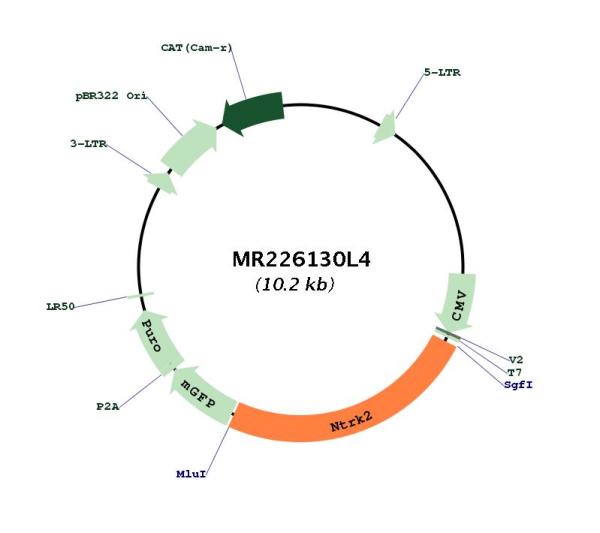Ntrk2 (NM_001025074) Mouse Tagged Lenti ORF Clone
CAT#: MR226130L4
- LentiORF®
Lenti ORF clone of Ntrk2 (mGFP-tagged) - Mouse neurotrophic tyrosine kinase, receptor, type 2 (Ntrk2), transcript variant 1
"NM_001025074" in other vectors (4)
Interest in protein/lysate? Submit request here!
USD 365.00
Specifications
| Product Data | |
| Type | Mouse Tagged ORF Clone |
| Tag | mGFP |
| Symbol | Ntrk2 |
| Synonyms | GP145-TrkB/GP95-TrkB; Tkrb; trk-B; trkB |
| Vector | pLenti-C-mGFP-P2A-Puro |
| E. coli Selection | Chloramphenicol (34 ug/mL) |
| Mammalian Cell Selection | Puromycin |
| Sequence Data |
The ORF insert of this clone is exactly the same as(MR226130).
|
| Restriction Sites |
SgfI-MluI
Cloning Scheme for this gene
Plasmid Map

|
| ACCN | NM_001025074 |
| ORF Size | 2463 bp |
| OTI Disclaimer | The molecular sequence of this clone aligns with the gene accession number as a point of reference only. However, individual transcript sequences of the same gene can differ through naturally occurring variations (e.g. polymorphisms), each with its own valid existence. This clone is substantially in agreement with the reference, but a complete review of all prevailing variants is recommended prior to use. More info |
| OTI Annotation | This clone was engineered to express the complete ORF with an expression tag. Expression varies depending on the nature of the gene. |
| Product Components | The ORF clone is ion-exchange column purified and shipped in a 2D barcoded Matrix tube containing 10ug of transfection-ready, dried plasmid DNA (reconstitute with 100 ul of water). |
| Reconstitution | 1. Centrifuge at 5,000xg for 5min. 2. Carefully open the tube and add 100ul of sterile water to dissolve the DNA. 3. Close the tube and incubate for 10 minutes at room temperature. 4. Briefly vortex the tube and then do a quick spin (less than 5000xg) to concentrate the liquid at the bottom. 5. Store the suspended plasmid at -20°C. The DNA is stable for at least one year from date of shipping when stored at -20°C. |
| Reference Data | |
| RefSeq | NM_001025074.1, NP_001020245.1 |
| RefSeq Size | 4614 bp |
| RefSeq ORF | 2466 bp |
| Locus ID | 18212 |
| UniProt ID | P15209 |
| Cytogenetics | 13 31.2 cM |
| Gene Summary | Receptor tyrosine kinase involved in the development and the maturation of the central and the peripheral nervous systems through regulation of neuron survival, proliferation, migration, differentiation, and synapse formation and plasticity. Receptor for BDNF/brain-derived neurotrophic factor and NTF4/neurotrophin-4. Alternatively can also bind NTF3/neurotrophin-3 which is less efficient in activating the receptor but regulates neuron survival through NTRK2. Upon ligand-binding, undergoes homodimerization, autophosphorylation and activation. Recruits, phosphorylates and/or activates several downstream effectors including SHC1, FRS2, SH2B1, SH2B2 and PLCG1 that regulate distinct overlapping signaling cascades. Through SHC1, FRS2, SH2B1, SH2B2 activates the GRB2-Ras-MAPK cascade that regulates for instance neuronal differentiation including neurite outgrowth. Through the same effectors controls the Ras-PI3 kinase-AKT1 signaling cascade that mainly regulates growth and survival. Through PLCG1 and the downstream protein kinase C-regulated pathways controls synaptic plasticity. Thereby, plays a role in learning and memory by regulating both short term synaptic function and long-term potentiation. PLCG1 also leads to NF-Kappa-B activation and the transcription of genes involved in cell survival. Hence, it is able to suppress anoikis, the apoptosis resulting from loss of cell-matrix interactions. Isoform GP95-TRKB may also play a role in neutrophin-dependent calcium signaling in glial cells and mediate communication between neurons and glia.[UniProtKB/Swiss-Prot Function] |
Documents
| Product Manuals |
| FAQs |
| SDS |
Resources
Other Versions
| SKU | Description | Size | Price |
|---|---|---|---|
| MC221856 | Ntrk2 (untagged) - Mouse neurotrophic tyrosine kinase, receptor, type 2 (Ntrk2), transcript variant 1, (10ug) |
USD 753.00 |
|
| MG226130 | Ntrk2 (tGFP-tagged) - Mouse neurotrophic tyrosine kinase receptor type 2 (Ntrk2) transcript variant 1, (10ug) |
USD 952.00 |
|
| MR226130 | Ntrk2 (Myc-DDK-tagged) - Mouse neurotrophic tyrosine kinase, receptor, type 2 (Ntrk2), transcript variant 1 |
USD 752.00 |
|
| MR226130L3 | Lenti ORF clone of Ntrk2 (Myc-DDK-tagged) - Mouse neurotrophic tyrosine kinase, receptor, type 2 (Ntrk2), transcript variant 1 |
USD 1,052.00 |
{0} Product Review(s)
Be the first one to submit a review






























































































































































































































































 Germany
Germany
 Japan
Japan
 United Kingdom
United Kingdom
 China
China

